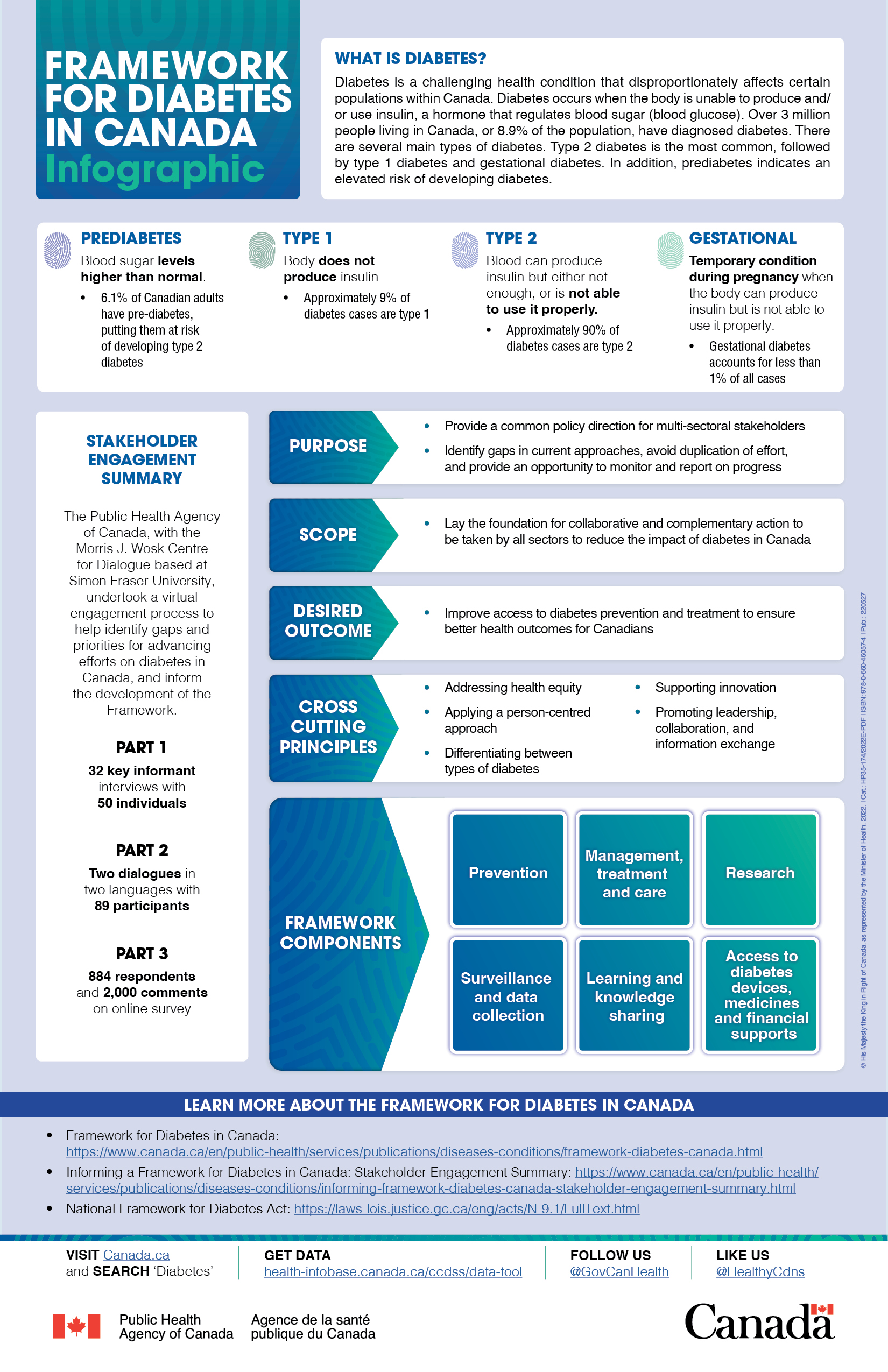Framework for Diabetes in Canada: Infographic
Download in PDF format
(1 MB, 1 page)
Published: 2022-11-24
What is diabetes?
Diabetes is a challenging health condition that disproportionately affects certain populations within Canada. Diabetes occurs when the body is unable to produce and/or use insulin, a hormone that regulates blood sugar (blood glucose). Over 3 million people living in Canada, or 8.9% of the population, have diagnosed diabetes. There are several main types of diabetes. Type 2 diabetes is the most common, followed by type 1 and gestational diabetes. In addition, prediabetes indicates an elevated risk of developing type 2 diabetes.
- Prediabetes: Blood sugar levels higher than normal.
- 6.1% of Canadian adults have pre-diabetes, putting them at risk of developing type 2 diabetes.
- Type 1: Body does not produce insulin.
- Approximately 9% of diabetes cases are type 1.
- Type 2: Body can produce insulin but either not enough, or it is not able to use it properly.
- Approximately 90% of diabetes cases are type 2.
- Gestational: Temporary condition during pregnancy when the body can produce insulin but is not able to use it properly.
- Gestational diabetes accounts for less than 1% of all cases.
Framework for Diabetes in Canada (Framework)
Purpose: The purpose of the Framework for Diabetes in Canada is to:
- provide a common policy direction for multi-sectoral stakeholders
- identify gaps in current approaches, avoid duplication of effort, and provide an opportunity to monitor and report on progress
Scope: The Framework lays the foundation for collaborative and complementary action to be taken by all sectors to reduce the impact of diabetes in Canada.
Desired outcome of the Framework is to improve access to diabetes prevention and treatment to ensure better health outcomes for Canadians.
Cross-cutting principles: The Framework identifies several cross-cutting principles that should guide efforts to address diabetes in Canada:
- addressing health equity
- applying a person-centred approach
- differentiating between types of diabetes
- supporting innovation
- promoting leadership, collaboration and information exchange
Framework components: The Framework organizes efforts into six separate Framework components:
- prevention
- management, treatment and care
- research
- surveillance and data collection
- learning and knowledge sharing
- access to diabetes devices, medicines and financial supports
Stakeholder engagement summary
The Public Health Agency of Canada, with the Morris J. Wosk Centre for Dialogue based at Simon Fraser University, undertook a virtual engagement process to help identify gaps and priorities for advancing efforts on diabetes in Canada, and inform the development of the Framework.
- Part 1: 32 key information interviews with 50 individuals
- Part 2: 2 dialogues in 2 languages with 89 participants
- Part 3: 884 respondents and 2,000 comments on online survey
Learn more about the Framework for Diabetes in Canada
- Framework for Diabetes in Canada
- Informing a Framework for Diabetes in Canada: Stakeholder Engagement Summary
- National Framework for Diabetes Act
Visit Canada.ca and search ‘Diabetes’
Get data: health-infobase.canada.ca/ccdss/data-tool
Follow us: @GovCanHealth
Like us: @HealthyCdns
